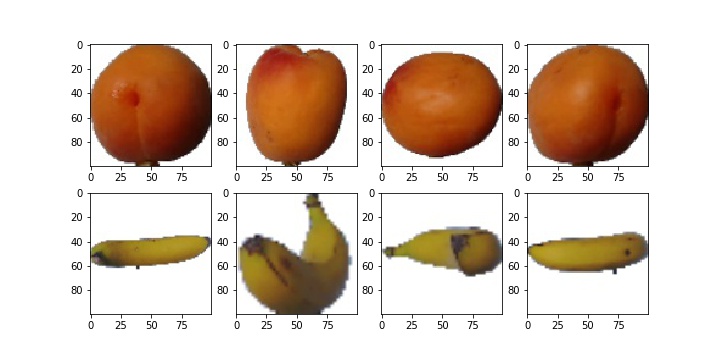Keras’ ImageDataGenerator class allows the users to perform image augmentation while training the model. If you do not have sufficient knowledge about data augmentation, please refer to this tutorial which has explained the various transformation methods with examples. You can also refer this Keras’ ImageDataGenerator tutorial which has explained how this ImageDataGenerator class work.
Keras’ ImageDataGenerator class provide three different functions to loads the image dataset in memory and generates batches of augmented data. These three functions are:
- .flow()
- .flow_from_directory()
- .flow_from_dataframe.()
Each of these function is achieving the same task to loads the image dataset in memory and generates batches of augmented data, but the way to accomplish the task is different.
This tutorial has explained flow() function with example.
Prepare Dataset
For demonstration, we use the fruit dataset which has two types of fruit such as banana and Apricot. Each class contain 50 images. You can download the dataset here and save & unzip it in your current working directory. we need to train a classifier which can classify the input fruit image into class Banana or Apricot.
Let’s plot the images of train data.
In [1]:
%matplotlib inline
import matplotlib.pyplot as plt
import os
src_path = "data/train/"
sub_class = os.listdir(src_path)
fig = plt.figure(figsize=(10,5))
path = os.path.join(src_path,sub_class[0])
for i in range(4):
plt.subplot(240 + 1 + i)
img = plt.imread(os.path.join(path,str(i)+'.jpg'))
plt.imshow(img, cmap=plt.get_cmap('gray'))
path = os.path.join(src_path,sub_class[1])
for i in range(4,8):
plt.subplot(240 + 1 + i)
img = plt.imread(os.path.join(path,str(i)+'.jpg'))
plt.imshow(img, cmap=plt.get_cmap('gray'))
Out[1]:

Implementing a training Script
Let’s import the required packages.
In [2]: from keras.models import Sequential from keras.layers import Conv2D, MaxPooling2D, Dense, Flatten, Dropout from keras.preprocessing.image import ImageDataGenerator from keras.utils import to_categorical from sklearn.preprocessing import LabelEncoder from sklearn.model_selection import train_test_split import numpy as np import cv2 import os
Let’s load the train images and test images.
In [3]:
src_path = "data/train"
train_data = []
train_label = []
for e in os.listdir(src_path):
path = os.path.join(src_path,e)
for x in os.listdir(path):
img = cv2.imread(os.path.join(path,x))
train_data.append(img)
train_label.append(e)
In [4]:
src_path = "data/test"
test_data = []
for e in os.listdir(src_path):
img = cv2.imread(os.path.join(src_path,e))
test_data.append(img)
Let’s normalized each pixel values to the range [0,1] and encode the target label.
In [5]: train_data = np.array(train_data, dtype="float") / 255.0 test_data = np.array(test_data, dtype="float") / 255.0 le = LabelEncoder() train_label = le.fit_transform(train_label) train_label = to_categorical(train_label) (trainX, valX, trainY, valY) = train_test_split(train_data, train_label, test_size=0.20, random_state=42)
Let’s initialize the Keras’ ImageDataGenerator class
In [6]:
train_datagen = ImageDataGenerator(
rotation_range=20,
zoom_range=0.15,
width_shift_range=0.2,
height_shift_range=0.2,
shear_range=0.15,
horizontal_flip=True,
fill_mode="nearest")
test_datagen = ImageDataGenerator()
Let’s create our train generator, validation generator and test generator
In [7]: batch_size = 8 train_generator = train_datagen.flow(trainX, trainY, batch_size=batch_size) valid_generator = train_datagen.flow(trainX, trainY, batch_size=batch_size) test_generator = test_datagen.flow(test_data, batch_size=1)
Let’s prepare a convolutional neural network (CNN).
In [8]:
def prepare_model():
model = Sequential()
model.add(Conv2D(32,kernel_size=(3,3),activation='relu',input_shape=(100, 100, 3)))
model.add(MaxPooling2D(pool_size=(2, 2)))
model.add(Flatten())
model.add(Dense(16, activation='relu'))
model.add(Dense(1, activation='sigmoid'))
model.compile(loss="binary_crossentropy",optimizer="adam",metrics=['accuracy'])
return model
Let’s train the model:
In [9]: model = prepare_model() model.fit_generator(train_aug, validation_data=(testX, testY), steps_per_epoch=len(trainX) // batch_size, epochs=5) Out[9]: Epoch 1/5 10/10 [==============================] - 2s 182ms/step - loss: 0.7499 - acc: 0.5875 - val_loss: 0.3824 - val_acc: 0.7125 Epoch 2/5 10/10 [==============================] - 1s 130ms/step - loss: 0.3015 - acc: 0.7500 - val_loss: 0.2117 - val_acc: 0.7625 Epoch 3/5 10/10 [==============================] - 1s 127ms/step - loss: 0.2017 - acc: 0.8250 - val_loss: 0.1759 - val_acc: 0.9812 Epoch 4/5 10/10 [==============================] - 1s 125ms/step - loss: 0.1159 - acc: 1.0000 - val_loss: 0.0284 - val_acc: 1.0000 Epoch 5/5 10/10 [==============================] - 1s 132ms/step - loss: 0.0109 - acc: 1.0000 - val_loss: 0.0062 - val_acc: 1.0000
Let’s evaluate our Model
In [10]:
score = model.evaluate_generator(valid_generator)
print('Test loss:', score[0])
print('Test accuracy:', score[1])
Out[10]:
Test loss: 0.00240
Test accuracy: 1.0
Let’s make a prediction on test data using Keras’ predict_generator:
In [11]: predict = model.predict_generator(test_generator) # predict the class label y_classes = predict.argmax(axis=-1)
. . .